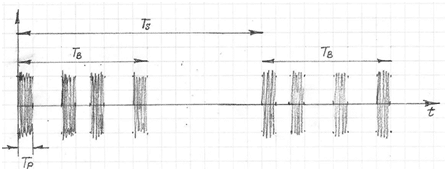Impulse noise or impulsive interference performance is one of the major distortion factors in a TV broadcasting channel. The source of the impulse noise may be natural, such as lightning, or man-made, such as sparks in ignition or switching devices (e.g. light switches, furnace, dishwasher etc.).

Impulse noise is very chaotic and random in nature; therefore determining its mathematical and statistical relationships is a difficult, almost impossible, task. Impulsive noise can be described as a number of repetitive or non-repetitive pulses with a random intensity, duration and occurrence.

Impulse noise may be modeled as a sequence of bursts that have a particular burst duration TB. Each burst appears with burst spacing TS. Within a burst, the pulses of Gaussian noise are randomly distributed. Each pulse has the same pulse duration TP. Each burst must have the same number of pulses. The level of Gaussian noise within all the pulses must be the same and respectively high. There is a case (Figure 2) when within one burst duration only one pulse with TP = TB is located.
The number models of the impulse noise measured by BBC R&D [1] are represented in the table:
| Noise type | TP(µs) | Pulses per Burst | Min burst duration TB (µs) | Max burst duration TB(µs) | Effective burst duration(µs) |
| N1 | 25 ± 10 | 6 | 75.25 | 175.25 | 1.5 |
| N2 | 2 ± 0.5 | 2 | 1.75 | 2.75 | 0.5 |
| N3 | 1.5 ± 0.5 | 20 | 19.25 | 38.25 | 5 |
| N4 | 12.5 ± 2.5 | 10 | 90.25 | 135.25 | 2.5 |
| N5 | 25 ± 20 | 2 | 5.25 | 45.25 | 0.5 |
| N6 | 7.5 ± 2.5 | 2 | 5.25 | 10.25 | 0.5 |
| N7 | N/A | 1 | 1 | N/A | 0.25 |
Burst spacing is assumed TS = 10ms.
Contrary to BD, which includes the time spacing between pulses, the effective burst duration is defined as the number of pulses per burst, times the pulse duration.
More Information
References
- Modelling impulsive interference in DVB-T: statistical analysis, test waveforms and receiver performance, BBC R&D, J. Lago-Fernandez, J. Salter Jan 2004.